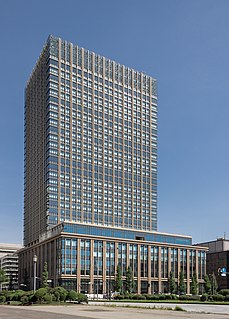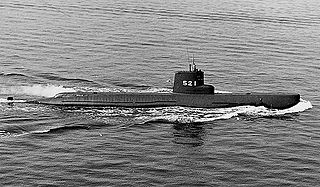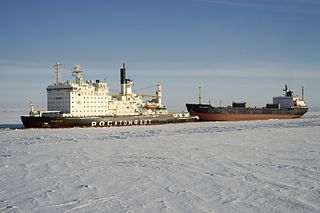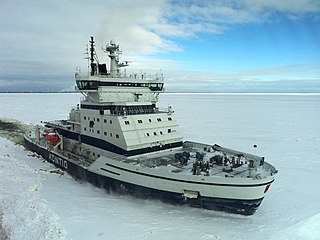Related Research Articles

A bearing is a machine element that constrains relative motion to only the desired motion, and reduces friction between moving parts. The design of the bearing may, for example, provide for free linear movement of the moving part or for free rotation around a fixed axis; or, it may prevent a motion by controlling the vectors of normal forces that bear on the moving parts. Most bearings facilitate the desired motion by minimizing friction. Bearings are classified broadly according to the type of operation, the motions allowed, or to the directions of the loads (forces) applied to the parts.

Mitsubishi Heavy Industries, Ltd. is a Japanese multinational engineering, electrical equipment and electronics corporation headquartered in Tokyo, Japan. MHI is one of the core companies of the Mitsubishi Group and its automobile division is the predecessor of Mitsubishi Motors.

Gasoline direct injection (GDI), also known as petrol direct injection (PDI), is a mixture formation system for internal combustion engines that run on gasoline (petrol), where fuel is injected into the combustion chamber. This is distinct from manifold fuel injection systems, which inject fuel into the intake manifold.

Prairie-Masker is a radiated noise reduction system fitted to some western warships, including the Oliver Hazard Perry-class frigates, Spruance and Arleigh Burke-class destroyers, and the Ticonderoga-class cruisers of the US Navy. The system was also installed during the 1960s on a limited number of post WWII Guppy III modified, and later diesel submarines.
Mals or MALS may refer to:

The Hayashio-class submarine was the successor design to the Japanese submarine Oyashio, and the predecessor of the Natsushio class with the Japan Maritime Self-Defense Force. Ordered in 1959, the boats were small with limited capability but were successful. Constructed in Japan from 1960 to 1962, they remained in service until 1979 when they were discarded.
Reinforced Impact Safety Evolution (RISE) or Realized Impact Safety Evolution is the brand name of Mitsubishi's patented safety body construction system. It was first introduced in the 1996 Mitsubishi Galant. Initially designed to improve passive safety, the system has subsequently been developed to electronically integrate every aspect of car's active and passive safety features.

Taymyr is a shallow-draft nuclear-powered icebreaker, and the first of two similar vessels. She was built in 1989 for the Soviet Union in Finland, at the Helsinki Shipyard by Wärtsilä Marine, by order of the Murmansk Shipping Company. Her sister ship is Vaygach.

Vaygach is a shallow-draught nuclear-powered icebreaker. She was built in 1989 for the Soviet Union by Wärtsilä Marine Helsinki Shipyard in Finland by order of the Murmansk Shipping Company. Her sister ship is Taymyr.

USCGC Sturgeon Bay is the newest of the United States Coast Guard 140-foot (43 m) Bay-class cutters. Homeported in Bayonne, New Jersey, the primary missions of Sturgeon Bay and her crew are Domestic Icebreaking and Ports, Waters, & Coastal Security. During the winter months, Sturgeon Bay is responsible for providing search and rescue capabilities to the ice-covered areas in New York City and the Hudson Valley, as well as throughout coastal New England. The cutter also facilitates the safe navigation of commercial product, including gasoline and heating oil, through the ice-choked Hudson River from New York City to Albany. All Bay-class cutters, including Sturgeon Bay, use a low-pressure-air hull lubrication or bubbler system that forces air and water between the hull and ice. This system improves icebreaking capabilities by reducing resistance against the hull, reducing horsepower requirements.
Antiroll tanks are tanks fitted onto ships in order to improve the tank's response to roll motion. Fitted with baffles intended to slow the rate of water transfer from the port side of the tank to the starboard side and the reverse, the tanks are designed such that a larger amount of water is trapped on the higher side of the vessel. This is intended to reduce the roll period of the hull by acting in opposition to the free surface effect. They can be broadly classified into active and passive antiroll tanks.

Kontio is a Finnish state-owned icebreaker. Built by Wärtsilä Helsinki shipyard in 1987 as a replacement for the aging Karhu-class icebreakers, she and her sister ship Otso were the first Finnish post-war icebreaker to be built without bow propellers.

Otso is a Finnish state-owned icebreaker. Built by Wärtsilä Helsinki shipyard in 1986 to replace the aging Karhu-class icebreakers, she was the first Finnish post-war icebreaker to be built without bow propellers. Otso has an identical sister ship, Kontio, which was delivered in 1987.
Air cavity system is a modern marine hull design concept based upon capturing air beneath a vessel's hull to reduce drag and increase speed and fuel efficiency.

AIDAprima is the flagship of AIDA Cruises, built by Mitsubishi Shipbuilding at their shipyard in Nagasaki, Japan. The cruise ship entered service on April 25, 2016, after suffering several construction delays. She is the first AIDA vessel not to be built in Meyer Werft since the completion of AIDAaura in 2003. She is also the first Carnival Corporation & plc vessel to be built in Mitsubishi since the completion of the Sapphire Princess in 2004.

USCGC Penobscot Bay is the seventh of nine United States Coast Guard 140-foot Bay-class icebreaking tugs. Homeported in Bayonne, New Jersey, the primary missions of Penobscot Bay and her crew are Domestic Icebreaking and Ports, Waterways, & Coastal Security. During the winter months, Penobscot Bay is responsible for providing search and rescue capabilities to the ice-covered areas in New York City and the Hudson Valley, as well as throughout coastal New England. The cutter also facilitates the safe navigation of commercial product, including gasoline and heating oil, through the ice-choked Hudson River from New York City to Albany. All Bay-class cutters, including Penobscot Bay, use a low-pressure-air hull lubrication or bubbler system that forces air and water between the hull and ice. This system improves icebreaking capabilities by reducing resistance against the hull, reducing horsepower requirements.

JS Nichinan (AGS-5105) is the only ship of her type of oceanographic research ship for the Japan Maritime Self-Defense Force.

USCGC Bristol Bay (WTGB-102) is the second vessel of the Bay-class tugboats built in 1978 and operated by the United States Coast Guard. The ship was named after the body of water formed by the Alaskan peninsula, which emptied into the Bering Sea.

USCGC Neah Bay (WTGB-105) is the fifth vessel of the Bay-class tugboat built in 1980 and operated by the United States Coast Guard. The ship was named after a bay located within the state of Washington and bordered by Puget Sound.

USCGC Thunder Bay (WTGB-108) is the eighth vessel of the Bay-class tugboat built in 1985 and operated by the United States Coast Guard. The ship was named after a bay in the U.S. state of Michigan on Lake Huron.
References
- ↑ MALS Archived 2014-02-26 at the Wayback Machine
- ↑ PDF file Archived 2013-03-04 at the Wayback Machine
- ↑ Raunek (January 24, 2021). "How Air Lubrication System for Ships Works?" . Retrieved 2022-10-31.